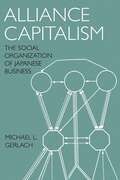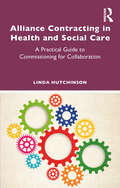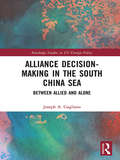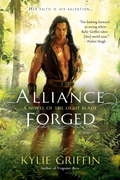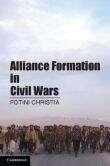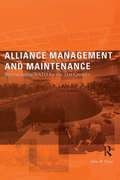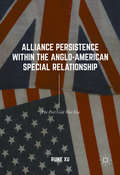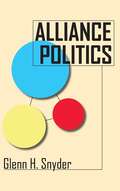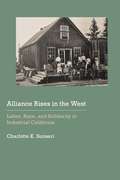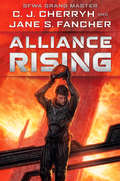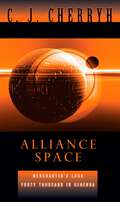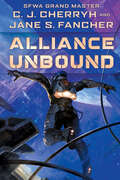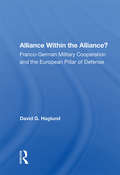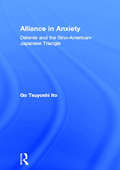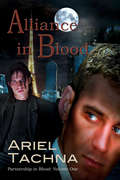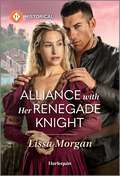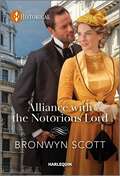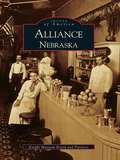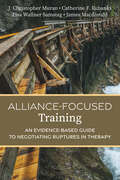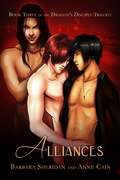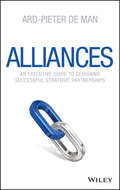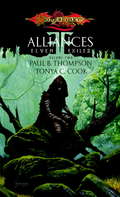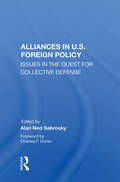- Table View
- List View
Alliance Capitalism: The Social Organization of Japanese Business
by Michael L. GerlachBusiness practices in Japan inspire fierce and even acrimonious debate, especially when they are compared to American practices. This book attempts to explain the remarkable economic success of Japan in the postwar period—a success it is crucial for us to understand in a time marked by controversial trade imbalances and concerns over competitive industrial performance.Gerlach focuses on what he calls the intercorporate alliance, the innovative and increasingly pervasive practice of bringing together a cluster of affiliated companies that extends across a broad range of markets. The best known of these alliances are the keiretsu, or enterprise groups, which include both diversified families of firms located around major banks and trading companies and vertical families of suppliers and distributors linked to prominent manufacturers in the automobile, electronics, and other industries. In providing a key link between isolated local firms and extended international markets, the intercorporate alliance has had profound effects on the industrial and social organization of Japanese businesses.Gerlach casts his net widely. He not only provides a rigorous analysis of intercorporate capitalism in Japan, making useful distinctions between Japanese and American practices, but he also develops a broad theoretical context for understanding Japan's business networks. Addressing economists, sociologists, and other social scientists, he argues that the intercorporate alliance is as much a result of overlapping political, economic, and social forces as are such traditional Western economic institutions as the public corporation and the stock market.Most compellingly, Alliance Capitalism raises important questions about the best method of exchange in any economy. It identifies situations where cooperation among companies is an effective way of channeling corporate activities in a world marked by complexity and rapid change, and considers in detail alternatives to hostile takeovers and other characteristic features of American capitalism. The book also points to the broader challenges facing Japan and its trading partners as they seek to coordinate their distinctive forms of economic organization.
Alliance Contracting in Health and Social Care: A Practical Guide to Commissioning for Collaboration
by Linda HutchinsonAlliance Contracting in Health and Social Care is a ground-breaking and practical guide to collaborating and co-ordinating service provision across different providers, taking readers through each step from initial concept to launch and operation.Responding to the need for more joined up services, the book explains how alliancing and alliance contracting can tackle the system issues which often stymie collaboration between different agencies. It takes a people-centred approach providing guidance for the legal, financial and governance frameworks needed for organisations to work together, ultimately providing better health and social care. Written by a leading expert in the field, it also features detailed examples of where alliancing has already proved successful, including services around mental health and homelessness in different regions of the UK.This important book will be essential reading for anyone commissioning services across the health and social care sector, in both the UK and beyond.
Alliance Decision-Making in the South China Sea: Between Allied and Alone (Routledge Studies in US Foreign Policy)
by Joseph A. GaglianoThe combination of rising Chinese power and longstanding territorial disputes has drawn increased attention and threats to the Asia-Pacific region. Five smaller powers contest Beijing’s claims; Malaysia, the Philippines, Vietnam, Brunei and Indonesia, with the United States viewed as the most likely counterbalance to coercive behavior towards them. However, only one of these five states - the Philippines -has maintained a guarantee of protection through alliance with the US. What factors have influenced state decisions to form security relationships with Washington, and what does the evolution of these factors portend for future security relationships in the South China Sea? Using research on U.S. policy preferences based on recently declassified material, this book produces conclusions previously inaccessible beyond classified forums. The author surveys recent alliance theory developments to examine relationships between claimant states and the US, explores historical bilateral relations and considers the future of regional security relationships. This book contributes to the fields of security studies, foreign policy and international relations and expands beyond traditional concepts of defense alliances to explore security cooperation along a spectrum from allied to aligned to non-aligned.
Alliance Forged
by Kylie GriffinThere is no mercy in the demon realm. No escape. In this place of desperation and conflict, anyone who is not purebred is virtually powerless. Until a blind priestess lays claim to a half-breed warrior, body and soul... Hunted and marked for death by Na'Reish demons for their half-blood heritage, the Na'Chi are searching for a new home--something an alliance offered by the human leader could provide. With both races divided by prejudice, when Light Blade rebels brutally attack the Na'Chi, the alliance seems doomed to fail. Varian, leader of the Na'Chi, a hybrid race of gifted warriors, is cursed with the darker impulses of his demon heritage. Controlling the part of himself that craves the high of the battle is a struggle he's afraid he'll lose--until he meets Kymora Tayn, a priestess driven to serve her deity. While he's unwilling to trust anyone outside his people, he finds himself drawn to Kymora's strength and passionate nature, and discovers she has the power to calm the darkness inside him. When the Na'Reish raid human territory for blood-slaves and kickstart the war, the key to the survival of both races--Na'Chi and human--is an alliance. However when Kymora is kidnapped, pitting human against human, Varian realizes he must embrace his darker half, not only to save the alliance...but also the woman he loves.
Alliance Formation in Civil Wars
by Fotini ChristiaSome of the most brutal and long-lasting civil wars of our time involve the rapid formation and disintegration of alliances among warring groups, as well as fractionalization within them. It would be natural to suppose that warring groups form alliances based on shared identity considerations – such as Christian groups allying with Christian groups – but this is not what we see. Two groups that identify themselves as bitter foes one day, on the basis of some identity narrative, might be allies the next day and vice versa. Nor is any group, however homogeneous, safe from internal fractionalization. Rather, looking closely at the civil wars in Afghanistan and Bosnia and testing against the broader universe of fifty-three cases of multiparty civil wars, Fotini Christia finds that the relative power distribution between and within various warring groups is the primary driving force behind alliance formation, alliance changes, group splits and internal group takeovers.
Alliance Management and Maintenance: Restructuring NATO for the 21st Century
by John R. DeniThe maintenance and management of the NATO alliance is a delicate balancing act between responding to security threats and navigating the bargaining positions of the member states. This book highlights how the alliance managed to maintain that balance in an area critical to its operations today around the world - changing its Cold War-era doctrine and structures. Based on his findings, John Deni debates whether the NATO alliance ought to be considered by policy makers to be a political organization first and a military one second. Providing new empirical data valuable to our understanding of NATO's post-Cold War evolution, the book offers a unique perspective on alliance management and maintenance. It sheds light on the continuing debate surrounding NATO's role in security, how the alliance will fight and whether NATO is properly structured to continue providing security for its member states.
Alliance Persistence within the Anglo-American Special Relationship
by Ruike XuThis book seeks to demystify the persistence of the Anglo-American Special Relationship (AASR) in the post-Cold War era by constructing a new theory of alliance persistence. This theory of alliance persistence not only has stronger explanatory power than the predominant model of interests and sentiments, but also opens a new way for understanding what factors have prevented the AASR from collapsing. This innovative new volume fills the gap in AASR literature by focusing on the important role of institutionalization in sustaining the AASR, a factor that has been significantly overlooked in existing academic research.
Alliance Politics
by Glenn H. SnyderFor those who are truly interested in the relationship between politics and the military, reading Alliance Politics is worth the effort.― LTC Laurence W. Mazzeno ― Military Review creates a theory of alliances by deductive reasoning about the international system, by integrating ideas from neorealism, coalition formation, bargaining, and game theory, and by empirical generalization from international history. Using cases from 1879 to 1914 to present a theory of alliance formation and management in a multipolar international system, he focuses particularly on three cases—Austria-Germany, Austria-Germany-Russia, and France-Russia—and examines twenty-two episodes of intra-alliance bargaining. Snyder develops the concept of the alliance security dilemma as a vehicle for examining influence relations between allies. He draws parallels between alliance and adversary bargaining and shows how the two intersect. He assesses the role of alliance norms and the interplay of concerts and alliances.
Alliance Rises in the West: Labor, Race, and Solidarity in Industrial California (Historical Archaeology of the American West)
by Charlotte K. SunseriAlliance Rises in the West documents the experiences of a company town at a critical moment in the rise of working-class consciousness in nineteenth-century California. Through archaeological research Charlotte K. Sunseri overcomes the silence of the documentary record to re-examine the mining frontier at Mono Mills, a community of multiple ethnic and racial groups, predominantly Chinese immigrants and Kudzadika Paiutes. The rise of political, economic, and social alliances among workers symbolized solidarity and provided opportunity to effect change in this setting of unequal power. Urban planning and neighborhood layout depict company structures of control and surveillance, while household archaeology from ethnically distinct neighborhoods speaks to lived experiences and how working-class identities emerged to crosscut ethnic and racial divides imposed in capitalism. Mono Mills&’s Paiute and Chinese communities experienced exclusionary legislation and brutal treatment on the basis of racial prejudice but lived alongside and built community with European American laborers, managers, and merchants who were also on an economic periphery. These experiences in Mono Mills and other nineteenth-century company towns did not occur in a vacuum; capitalists&’ control and ideologies of race and class all doubled down as American workers used collective action to change the rules of the system. In this rare, in-depth perspective, close consideration of the ghost towns that dot the landscape of the West shows the haunting elements of capitalism and racial structures that characterized Gilded Age society and whose legacies endure to this day.
Alliance Rising: The Hinder Stars I (Alliance-Union Universe #1)
by C. J. Cherryh Jane S. FancherSFWA Grand Master Cherryh returns to the Hugo-award winning Alliance-Union Universe with a thrilling entry in her far-reaching sci-fi saga.For years, the stations of the Hinder Stars, those old stations closest to Sol, have lagged behind the great megastations of the Beyond, like Pell and Cyteen. But new opportunities and fears arise when Alpha station receives news of an incoming ship with no identification. The denizens of Alpha wait anxiously for news about the outsiders, each with their own suspicions about the ship and its origins.Ross and Fallon, crew members of the Galway, believe the unidentified ship belongs to Pell and has come to investigate another massive ship docked at Alpha, The Rights of Man. Though Rights is under the command of the Earth Company, it is not quite perfected--and its true purpose is shrouded in mystery.James Robert Neihart, captain of Finity's End--a huge faster-than-light ship flown by one of the Merchanter Families--has heard whispers of The Rights of Man and wonders at its design and purpose, especially as Sol struggles to rival the progress of the Farther Stars. Now docked at Alpha, he must convince the crews that there is more to The Rights of Man than meets the eye.Because the reasons behind the creation of The Rights of Man, and its true plans, could change everything--not just for Sol, but for the Hinder Stars and the Beyond itslf.
Alliance Space (Alliance-Union Universe)
by C. J. CherryhTwo Alliance-Union novels, Merchanter's Luck and Forty Thousand in Gehenna, bound in one omnibus volume for the first time!Merchanter's Luck—His name was Sandor and he was the owner and entire crew of a tramp star-freighter that flew the Union planets under false papers and fake names. Her name was Allison and she was a proud but junior member of the powerful family whose mighty starship, Dublin Again, was the true queen of the spaceways. They met at Viking Station, she seeking a night’s dalliance, he desperately in search of a spacer assistant. Their fateful meeting was to lead to a record-breaking race to Pell Station, thereby catching the calculating eye of the grim commander of the Alliance battlecraft Norway, and a terrifying showdown at a deadly destination off the cosmic charts. Forty Thousand In Gehenna—When forty thousand human colonists are abandoned for political reasons on a planet called Gehenna, and re-supply ships fail to arrive, collapse seems imminent. Yet over the next two centuries, the descendants of the original colonists survive despite all odds by entering a partnership with the planet’s native intelligence—the lizard-like, burrowing calibans.
Alliance Unbound (The Hinder Stars #2)
by C. J. Cherryh Jane S. FancherThe 2nd novel of The Hinder Stars series returns to an intergalactic corporate conflict, set in the Hugo Award–winning Alliance-Union Universe.With deft prose and complex characters, Alliance Unbound is thought-provoking science fiction that shrewdly examines the technological and sociopolitical challenges of humanity&’s journey to the stars.When Cyteen opened up faster-than-light travel, it gave the technology for free to any ship that could reach it; and with that technology, it provided a map of jump-points, points of mass enabling starships to navigate hyperspace safely.The map of jump-points, however, stopped with the route to Alpha—thus excluding Sol, and Earth, and the Earth Company, whose gateway to the stars was Alpha. Cyteen knew exactly what it was doing with its gift. Sol and the EC could still reach Alpha with sub-light pusher-ships as it always had—but Sol and the Earth Company no longer had any authority in the Beyond.But Sol intends to take back control of its star-stations and stop Cyteen's unbridled expansion, however it can. To do that, they are willing to starve Alpha and concentrate their efforts on a huge FTLer capable of carrying military force.
Alliance Within The Alliance?: Franco-german Military Cooperation And The European Pillar Of Defense
by David G. HaglundThis book is about the Franco-German military cooperation. It discusses the ending of the Cold War, the likelihood of a continuation and deepening of security cooperation between France and Germany and the impact this might have upon the transformation of the Atlantic Alliance.
Alliance in Anxiety: Detente and the Sino-American-Japanese Triangle
by Go Tsuyoshi ItoFirst Published in 2003. Routledge is an imprint of Taylor & Francis, an informa company.
Alliance in Blood (Partnership in Blood #1)
by Ariel Tachna2nd EditionPartnership in Blood: Volume One Can a desperate wizard and a bitter, disillusioned vampire find a way to build the partnership that could save their world? In a world rocked by magical war, vampires are seen by many as less than human, as the stereotypical creatures of the night who prey on others. But as the war intensifies, the wizards know they need an advantage to turn the tide in their favor: the strength and edge the vampires can give them in the battle against the dark wizards who seek to destroy life as they know it. In a dangerous move and show of good will, the wizards ask the leader of the vampires to meet with them, so that they might plead their cause. One desperate man, Alain Magnier, and one bitter, disillusioned vampire, Orlando St. Clair, meet in Paris, and the fate of the world hangs in the balance of their decision: Will the vampires join the cause and form a partnership with the wizards to win the war?This second edition received minor revision and proofing for re-release in honor of the publication of Partnership Reborn, the final book in the series.
Alliance with Her Renegade Knight
by Lissa MorganA high-stakes medieval romance of duty vs. desire, as the knight is torn between completing his mission and following his heart…The knight&’s target…Becomes his greatest desire!From the moment wool merchant Isolda catches sight of Sir Henry, she senses a powerful bond. But the vigilante knight is tracking down the person penning seditious poems exposing corruption…poems she secretly wrote!Henry is torn after discovering Isolda&’s hidden identity, especially as he sympathizes with her cause. When Isolda&’s apprentice is murdered, Henry joins forces with her, hiding out in his manor, where passions run high! Yet after the traumatic death of his family, Henry can&’t let Isolda breach the walls around his heart. Still, he must find a way to earn her trust—their lives depend on it!From Harlequin Historical: Your romantic escape to the past.
Alliance with His Stolen Heiress
by Lydia San Andres"A sweet, satisfying, utterly intoxicating historical romance." - Olivia Waite, New York Times, on Compromised into a Scandalous MarriageA high-stakes romantic Caribbean escapeHe must earn her trustbefore he wins her heart!In distancing himself from his nefarious wealthy family, Julian Fuentes has gained a rebellious reputation. Still, he&’s shocked when heiress Amalia Troncoso hires him to stage her kidnapping! Julian doesn&’t mind masquerading as a bandit to help Amalia get her inheritance from her tyrannical uncle, or spending time with the bold heiress who&’s captured his imagination. But will the truth that ties their families together prevent their alliance from becoming more? From Harlequin Historical: Your romantic escape to the past.
Alliance with the Notorious Lord (Enterprising Widows #2)
by Bronwyn ScottA spicy annoyances-to-lovers Victorian romanceMixing business……with rakish pleasure! Recently widowed Antonia Lytton-Popplewell is determined to carve her place in a man&’s world. Yet turning a ramshackle property in London into a world-class department store isn&’t easy. Especially when her inheritance comes with strings in the form of her late husband&’s business partner, infuriatingly attractive Lord Cullen Allardyce. To ensure success, Antonia needs Cullen&’s guidance. But her alliance with society&’s most notorious rebel becomes even more complicated when begrudging respect turns into mutual desire… From Harlequin Historical: Your romantic escape to the past.Enterprising WidowsBook 1: Liaison with the Champagne CountBook 2: Alliance with the Notorious LordBook 3: A Deal with the Rebellious Marquess
Alliance, Nebraska (Images of America)
by Knight Museum Board and PartnersOnce heralded as the "Queen City of the Plains,"Alliance, Nebraska originated as a simple railroadjunction called Grand Lake. Founded on true pioneerspirit in 1887, Alliance has grown from a farm and ranchcommunity into a major retail center for Box Butte County.The Knight Museum showcases over 200 images in this newbook, depicting the history and growth of Alliance during its113-year history.Although there are many anonymous threads that makeup the social fabric of Alliance, readers will recognize themore familiar faces of the Newberry family, Dr. Frank Knight,Miss Susan Frazier, and Miss Katherine Schill. While somelandmarks are gone forever, such as the depot and the CoorsBuilding, many timeless photographs remain to guide thereader down the main street of Alliance's rich history. Fromthe vintage image of the county courthouse to the beautyof western Nebraska's largest park system, readers will get aglimpse of the pioneering spirit that is still so abundant.
Alliance-Focused Training: An Evidence-Based Guide to Negotiating Ruptures in Therapy
by James Macdonald J. Christopher Muran Catherine F. Eubanks Lisa Wallner SamstagThis book presents alliance-focused training (AFT), which helps therapists better anticipate, recognize, and repair ruptures in the therapeutic alliance. Decades of clinical research and experience have proven the essential contribution of the therapeutic alliance to psychological change and positive outcomes in therapy. A key element of a successful alliance is the ability to anticipate and navigate the inevitable misunderstandings and miscommunications that can lead to ruptures in the therapeutic relationship if unaddressed. But many therapists lack this ability, and they require training to fully address ruptures and repair therapeutic relationships with their clients. In this book, authors J. Christopher Muran, Catherine F. Eubanks, Lisa Wallner Samstag, and James Macdonald present alliance focused training (AFT), an empirically-supported, transtheoretical protocol which has been shown to increase patients&’ expressiveness, which is a key component in positive outcomes in therapy, as well as therapists&’ ability to recognize and tolerate their own negative reactions to clients. In AFT, therapists are given the opportunity to experiment with metacommunication, by which they can better explore their own internal experience and recognize conflicts as they emerge during alliance ruptures. Chapters first describe the background and research that led to the development of the protocol; next, the protocol itself is presented, with chapters on rupture recognition and rupture repair, via didactic instruction and experiential exercises. Then, rich and extensive case examples demonstrate how therapists can successfully use the protocol to identify and repair real ruptures with clients, and lead to long-lasting therapeutic change.
Alliances
by Anne Cain Barbara SheridanBarbara Sheridan and Anne Cain spin a magical tale in Book 3 of Dragon's Disciple. Trapped in a web of evil, four people will learn the true meaning of love and loyalty in Alliances.The sorceress Jaya works to revive an ancient evil. By joining forces with the centuries-old vampire Sakurai to obtain both their most sought after desires, they create a web of mistrust and seduction to ensnare four people crucial to their schemes: art professors Meg Silivasi and Leigh Gachelsing, along with Ken Ohara and his immortal lover, Dao Kan Shu. As malevolent forces and their own suspicions drive a wedge between the couples, loyalties are put to the ultimate test.Content Notes graphic m/m sex, strong language, non sexual violence and situations some readers may find disturbing
Alliances
by Ard-Pieter de ManA timely and practical guide that helps senior managers design successful strategic partnershipsStrategic alliances are increasingly common among modern corporations and a hot topic in today's business schools. Alliance is a sophisticated guide to crafting successful partnerships, offering a combination of carefully designed checklists, up-to-date examples and scenarios from around the world, and the tools needed to ensure that all elements of an alliance are taken into account and fully assessed. Most managers don't have the experience or knowledge to create a functional alliance governance structure. This book fills that knowledge gap with a clear description of the proper implementation process.Ideal for business leaders engaged in building a corporate alliance and business school studentsCovers all of the available alliance structure, describes the building blocks of alliance design, and defines an effective process for managers constructing alliancesWritten by a leading expert on the subject who is a member of the Board of Directors of the Association of Strategic Alliance ProfessionalsAs the popularity and frequency of corporate strategic alliances grows, Alliance gives business leaders the insight and practical advice they need to ensure their partnerships benefit all parties.
Alliances
by Lynne DavisWhen Indigenous and non-Indigenous activists work together, what are the ends that they seek, and how do they negotiate their relationships while pursuing social change? Alliances brings together Indigenous and non-Indigenous leaders, activists, and scholars in order to examine their experiences of alliance-building for Indigenous rights and self-determination and for social and environmental justice.The contributors, both Indigenous and non-Indigenous, come from diverse backgrounds as community activists and academics. They write from the front lines of struggle, from spaces of reflection rooted in past experiences, and from scholarly perspectives that use emerging theories to understand contemporary instances of alliance. Some contributors reflect on methods of mental decolonization while others use Indigenous concepts of respectful relationships in order to analyze present-day interactions. Most importantly, Alliances delves into the complex political and personal relationships inherent in both Indigenous and non-Indigenous struggles for social justice to provide insights into the tensions and possibilities of Indigenous-non-Indigenous alliance and coalition-building in the early twenty-first century.
Alliances (Dragonlance: Elven Exiles #2)
by Paul B. Thompson Tonya C. CookWhile the Elven Exiles struggle for survival in the distant kingdom of Khur, the elves remaining in Qualinesti face persecution, enslavement, and extermination. Amid great suffering and unrelieved evil, a rebel leader-masked, anonymous, and with strange powers-appears, determined to cleanse the land of invaders.Meanwhile, Kerianseray, the Lioness, Kagonesti general and wife of Speaker Gilthas, finds herself magically transported from certain death in Khur to equally dire straits in her former homeland. As Gilthas leads the elves across the trackless desert in search of a new home, the Lioness fights ruthless slavers and crosses paths with the mysterious masked revolutionary of Qualinesti.
Alliances In U.s. Foreign Policy: Issues In The Quest For Collective Defense
by Alan Ned SabroskyThis volume addresses a selected set of issues that appear to be especially salient with regard to alliances in U.S. foreign policy in general and to North Atlantic Treaty Organization in particular, presenting questions about alliance purpose and cohesion that demand a response.
